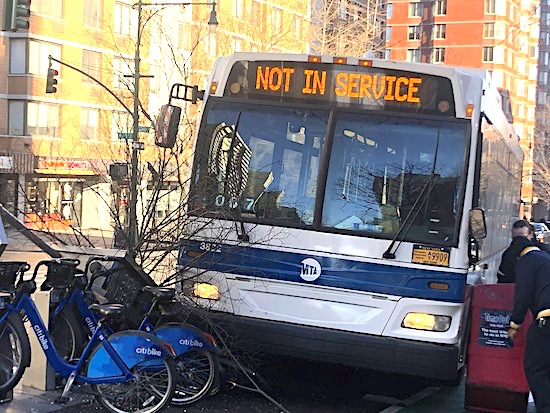MTA To Late-Night Transit Riders: Via Con Dios, Have a Lyft and Uber Uber Alles

Is the MTA curbing its enthusiasm for bus service?
The transportation agency is asking ride-hail companies to fill the gaps in the city’s transit deserts with a pilot program — called “Late Shift” — that seeks to provide late-night and early morning cab rides for commuters who would otherwise have to hike to a bus.
According to the agency’s request for proposals, e-hail companies would be summoned to move the rising population of employees who leave their jobs in the early morning hours to return to their homes in the Bronx, Brooklyn, Queens and Staten Island.
The pilot looks to serve a very specific — and fairly small — set of commuters: they must live outside Manhattan, at least a half-mile away from the nearest subway station, and must live in areas where the closest overnight bus lines don’t run more than every 20 minutes.
The MTA said it would pick a company to provide the service in March 2020.
Transit advocates were wary of this notion of innovation, which was first reported by The City.
“Ideally, we’d [meet] unmet demand for late-night service with more frequent off-peak bus service and subway service,” Riders Alliance spokesman Danny Pearlstein said. “I think if the MTA was announcing this as part of a multi-pronged approach to handling increased ridership in the off-peak, we would feel much more comfortable that the agency vetted this against the alternative possibilities.”
TransitCenter spokesman Ben Fried was more blunt: trust the bus.
“The MTA should be running more buses at night,” Fried said. “Operating resources that are going to these taxi rides are resources that aren’t going to buses.”
New York’s transit agency is hardly the first in the nation to look towards e-hail companies as (an optimist might say) a partner or (as a pessimist might say) a replacement for public transit. Cities such as Los Angeles, San Diego and Philadelphia have worked with companies such as Uber and Lyft to subsidize rides for commuters who are otherwise serviced by meager bus service.
But with bus network redesigns in the draft stage in both Queens and Brooklyn, and a campaign to get the MTA to expand the intra-city LIRR discount known as the Freedom Ticket, Pearlstein wondered why the agency feels it must look outside rather than deal with increased off-peak demand from within. An MTA spokesperson told Streetsblog that a pilot to study expanded transit options in the outer boroughs was included in the state’s congestion pricing law, and that the RFP was too “preliminary” to share the number of potential commuters it might serve.
But it is likely that ridership on some lines is so low late at night that it’s cheaper for the MTA to just hail those stragglers a cab. A recent MTA report on Brooklyn ridership shows that some weekday buses between midnight and 3 a.m. run their routes 80 percent empty (see page 81).
The focus on e-hail companies touched a nerve with City Council Transportation Committee Chairman Ydanis Rodriguez though, who said the MTA should have looked closer to home if it was going to ask cabs to pick up the slack in outer borough transit deserts.
“Livery [taxi] bases have the capacity and technological competence to fill the gap in service to New Yorkers living in transit deserts as well as Uber and Lyft, and have the added benefit to already have meaningful relationships with the communities in need,” Rodriguez said in a statement. “The MTA should have looked into ways to partner with local Livery bases before prioritizing the high-volume app-based companies.”





